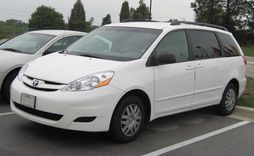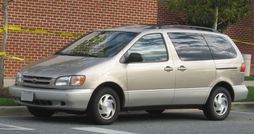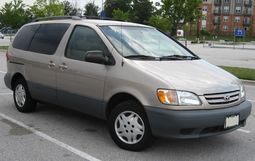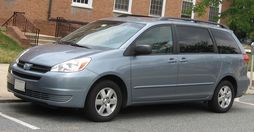The History Of Toyota Sienna

Not to be confused with Toyota Sienta.
The Toyota Sienna is a family minivan currently manufactured in the United States by the Japanese automaker Toyota for the North American market only, and shares its platform with the Toyota Camry. It is rumored to be exported to emerging markets such as China by the year 2010. The Sienna replaced the first generation Toyota Previa van in 1998 befitting as a more conventional front wheel drive layout, and was last updated in 2004 as a larger model. It is also used as a taxi in New York City.
In late 1997, Toyota launched the smaller front wheel drive 1998 Toyota Sienna in the North American market as a replacement for the rather avant-garde mid-engined Toyota Previa (the Previa nameplate is still available in Eurasia, and being sold in Japan as well as in some other nearby markets as the Toyota Estima). The Toyota Sienna debuted with a 3.0-liter 1MZ-FE V6 engine rated at 145 kW and 284N·m (209lb·ft) of torque. Built on an extended platform of the Toyota Camry, the Sienna was appropriately marketed as the "Camry of minivans". The Sienna also touted the best-in-class fuel economy (in miles per gallon) of any minivan which was rated at 18 city/ 24 highway. It was built in Georgetown, Kentucky. Shortly after its release (one year later), the Sienna faced new competition from Toyota's familiar rival Honda with their new ground-breaking Odyssey minivan.
For 2001 model year, the Sienna underwent a minor mid-cycle refresh. This update included a facelift to both front and rear fascias which added a redesigned front grille and bumper along with revised rear taillights sporting a more modern appearance (clear-lens turn-signals as opposed to amber-coloured). Toyota also revamped the center console area to add more usability to the HVAC controls along with new locations for the accessory switches (Rear Vent, Power Sliding Doors, Heated Seats). The engine now came equipped with a Variable valve timing feature VVT-i boosting output to 210hp (157kW) and 220lb·ft (298N·m) torque. This generation was noteworthy for its impressive safety content as one of the few minivans to offer competitive options including anti-lock brakes, Vehicle Skid Control (VSC), traction control and SRS Side-impact airbags.
In January 2003, the second-generation Sienna was unveiled at the Detroit Auto Show. Production shifted to Princeton, Indiana, and the former Georgetown plant was retooled to build the second generation Camry Solara. This redesign continued to be offered in CE, LE, and XLE trims along with the arrival of a new addition to the lineup: the more luxurious, leather-trimmed XLE Limited model. All Siennas were now powered by a new 3.3-liter 3MZ-FE engine paired with a new 5-speed automatic transmission ( The U151E in FWD models and the U151F in AWD Models)The gear-shift lever was also moved from the steering column to the lower-center dashboard area and worked in a zig-zag pattern much like that on the Lexus RX. Having grown larger in size than the first generation, the Sienna now offered a variety of new features, many of which were novelties derived from other competition within segment. A prime example of this was the clever hide-away third-row seat that stowed away folding flat into a floorwell (that could also be used to store grocery-bags when not occupied) to become level with the cargo floor, which was first revolutionized by the Honda Odyssey (a rival minivan) and followed by nearly every other minivan. However, while the Odyssey's "Magic Seat" was a one-piece folding bench, the Sienna's was made even more innovative by a convenient 60/ 40 split configuration for enhanced versatility. Power-retractable side-windows integrated into the second-row sliding-doors (first introduced in the Mazda MPV) were also new along with available eight-passenger seating (CE and LE only), power sliding doors and power liftgate (standard on XLE and Limited, optional on LE), High-intensity discharge (HID) Xenon headlamps (XLE Limited), radar-based "intelligent" cruise control (optional), front and rear obstacle detection (optional), "kid-view" mirror, voice-activated navigation system (optional, includes backup camera), remote keyless entry, tilt-and-telescopic steering wheel, rear climate control, heavy-duty tow-ready package, rear-seat DVD entertainment system, tire-pressure monitor, and run-flat tires that came standard with the available all wheel drive. Fuel economy remained commendable at 19 city and 26 highway (17 city/ 23 highway for AWD). All 2004-2007 Siennas also came standard with a factory tow package and a 3500lb towing capacity.
In July 2005, Toyota announced early changes for the 2006 model year. The front fascia, side molding, and rear taillamps were redesigned. The measurements for horsepower and torque were changed to the SAE's new specifications (from 230 hp and 242 ft·lbf to 215 hp and 222 ft·lbf, respectively). Blue-backlit electroluminescent "Optitron" gauges were added to LE, XLE, and Limited trims. The "XLE" prefix in "XLE Limited" was removed to lessen confusion, and newly added equipment exclusively for this trimline included an optional memory function for the power driver's seat (also available on XLE as an option) and power-folding exterior side-view mirrors with integrated turn-signal repeaters. Secondary options included Bluetooth capability and a power-folding third-row seat. Front side-torso airbags and head-protection curtain airbags for all three rows became standard equipment (formerly an option as part of a package) across the board. The optional rear seat audio system was discontinued.
For 2007, a new 2GR-FE 3.5-liter V6 engine putting out 266hp (198kW) replaced the old unit, and a new seven-spoke alloy wheel design was made exclusive to the Limited and AWD models.
For 2009, the Sienna remains largely unchanged save for a revision in pricing to become even more competitive through several available comprehensively-equipped "extra-value package" offerings. In the Canadian market, base prices are lowered by up to as much as $1,500.
2004:
- Car and Driver's Five Best Trucks Van Award
- Edmunds Editor's Most Wanted Van and Edmund Consumer's Most Wanted Van
- Rated "Double Best Pick" by IIHS PDF
The 2008 Toyota Sienna is available in:
- CE ($24,340 USD MSRP)
- CE 8-Passenger (24,490 USD MSRP)
- LE ($25,865 USD MSRP)
- LE 8-Passenger ($26,015 USD MSRP)
- LE AWD (29,035 USD MSRP)
- XLE ($29,525 USD MSRP)
- XLE AWD ($32,285 USD MSRP)
- Limited ($35,465 USD MSRP)
- Limited AWD ($37,665 USD MSRP)
Sienna from Toyota - 2008 Models, Features, & Prices (January 7, 2008)
- Engine: 3.5L DOHC 24-valve Dual VVT-i V6 - 2GR-FE
- Output: 266hp (200kW) at 6200RPM and 248ft·lbf (336N·m) at 4700rpm (SAE Net)
- Transmission: 5-speed electronically controlled automatic transmission with Intelligent Grade-Logic Control (ECT-i)
- MPG: EPA Estimated 23 MPG Highway, 17 MPG City (2WD), and 21 Highway, 16 City (AWD).
- Drivetrain: Front wheel drive, all wheel drive available on LE, XLE, XLE Limited (CE in Canada)
- Turning Diameter: 36.8ft (11.2m)
- Brakes: Power-assisted ventilated front disc, rear disk with anti-lock braking system (ABS), and 4-channel disc brakes on XLE Limited, all wheel drive models or with available Vehicle Stability Control system and Braking Assist
- A yellow 04-05 Toyota Sienna taxi is driven as the primary vehicle in the game show Cash Cab.
- A light-blue 04-05 Toyota Sienna CE is the family minivan featured in the Disney movie The Pacifier.
- The YTV van used in the Long Day Weekend Trip is a Sienna painted with the YTV Logo.
From Wikipedia, the free encyclopedia
More About Toyota Sienna




|